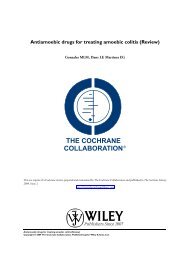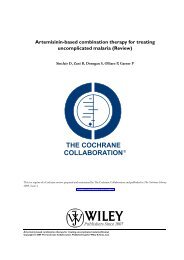Topical treatments for fungal infections of the skin and nails of the foot.
Topical treatments for fungal infections of the skin and nails of the foot.
Topical treatments for fungal infections of the skin and nails of the foot.
You also want an ePaper? Increase the reach of your titles
YUMPU automatically turns print PDFs into web optimized ePapers that Google loves.
(i) Placebo controlled trials<br />
Allylamines Versus Placebo<br />
Two different allylamines (naftifine 1% <strong>and</strong> terbinafine 1%) used<br />
<strong>for</strong> 1 to 4 weeks were evaluated in 11 placebo controlled r<strong>and</strong>omised<br />
trials.<br />
Short-term outcome (two weeks)<br />
Naftifine<br />
Short-term outcomes were available <strong>for</strong> all 5 trials using naftifine<br />
(n = 612) Klaschka 1984; Dobson 1989; Schachner 1990; Bagatell<br />
1991a; Bagatell 1991b. Overall <strong>the</strong> observed relative reduction<br />
in risk <strong>of</strong> treatment failure was 25% (RR 0.75, 95% CI 0.60 to<br />
0.93; Analysis 1.1), although <strong>the</strong>re was substantial variation in <strong>the</strong><br />
individual study results (I 2 = 79%).<br />
Terbinafine<br />
For terbinafine, short-term outcomes were available <strong>for</strong> 4 trials (n<br />
= 316, Berman 1992; Evans 1991; Korting 1997; Syed 2000). The<br />
results were inconsistent between studies, giving an overall relative<br />
reduction in treatment failure <strong>of</strong> 42% which was not statistically<br />
significant (RR 0.58, 95% CI 0.31 to 1.08; Analysis 1.1).<br />
Across all 9 trials providing short-term outcome <strong>of</strong> 1% allylamines<br />
<strong>for</strong> a period <strong>of</strong> 1 to 2 weeks compared with placebo, <strong>the</strong>re was a<br />
pooled relative reduction in treatment failure at 2 weeks <strong>of</strong> 31%<br />
(RR 0.69, 95% CI 0.56 to 0.87; Analysis 1.1), with substantial<br />
variation in individual study results (I 2 = 79%).<br />
Medium-term outcome (six weeks)<br />
Naftifine<br />
<strong>Topical</strong> <strong>treatments</strong> <strong>for</strong> <strong>fungal</strong> <strong>infections</strong> <strong>of</strong> <strong>the</strong> <strong>skin</strong> <strong>and</strong> <strong>nails</strong> <strong>of</strong> <strong>the</strong> <strong>foot</strong>. (Review)<br />
Copyright © 2009 The Cochrane Collaboration. Published by John Wiley & Sons, Ltd.<br />
Naftifine (1%) used <strong>for</strong> 4 weeks was evaluated in 5 trials (n = 607,<br />
Bagatell 1991a; Bagatell 1991b; Dobson 1989; Klaschka 1984;<br />
Schachner 1990), a 58% relative reduction in treatment failure was<br />
observed (RR 0.42 95% CI 0.30 to 0.59; Analysis 1.2, Naftifine (tx<br />
4 weeks) versus Placebo), with substantial variation in individual<br />
study results (I 2 = 68%).<br />
Terbinafine<br />
Terbinafine (1%) was used <strong>for</strong> 1 week (2 trials, n = 229, Berman<br />
1992; Korting 2001), 2 weeks (2 trials, n = 240, Evans 1991;<br />
Savin 1994) <strong>and</strong> 4 weeks (2 trials, n = 40, Savin 1990; Smith<br />
1990a). A statistically significant reduction in risk <strong>of</strong> treatment<br />
failure was observed with each treatment duration (RR 0.16, 0.36,<br />
0.18 respectively; Analysis 1.2). Pooling across all durations, a 77%<br />
relative reduction in treatment failure was observed (RR 0.23,<br />
95% CI 0.15 to 0.38, pooled result not shown in <strong>the</strong> Forest plots<br />
(MetaView), with moderate variation in individual study results<br />
(I 2 = 50%).<br />
A meta-analysis <strong>of</strong> data from all 11 trials (n = 1116) comparing 1%<br />
allylamines with placebo (treatment <strong>for</strong> a period <strong>of</strong> 1 to 4 weeks)<br />
provided an estimated relative reduction in <strong>the</strong> risk <strong>of</strong> treatment<br />
failure <strong>of</strong> 67% (RR 0.33, 95% CI 0.24 to 0.44; Analysis 1.2), with<br />
substantial variation in individual study results (I 2 = 67%). All<br />
<strong>of</strong> <strong>the</strong> results were based on at least 80% follow up except those<br />
from <strong>the</strong> trials evaluating terbinafine used <strong>for</strong> 2 weeks. A sensitivity<br />
analysis based on <strong>the</strong> exclusion <strong>of</strong> data collected in <strong>the</strong>se two trials<br />
(Evans 1991; Savin 1994) showed a similar overall estimate <strong>of</strong><br />
effectiveness (RR <strong>of</strong> treatment failure 0.31, 95% CI 0.21 to 0.45;<br />
Analysis 1.3). The variation in individual study results remained<br />
substantial (I 2 = 75%).<br />
A L’Abbé plot <strong>of</strong> <strong>the</strong> outcomes at 6 weeks (Figure 1) demonstrates<br />
that <strong>the</strong> allylamines generally had treatment failure rates <strong>of</strong> around<br />
30%, compared to around 85% <strong>for</strong> placebos, though <strong>the</strong>re was<br />
considerable variation in individual trial results (see MeMethods,<br />
Assessment <strong>of</strong> heterogeneity <strong>for</strong> more details <strong>of</strong> L’Abbé plots <strong>and</strong><br />
how to interpret <strong>the</strong>m) .<br />
7








